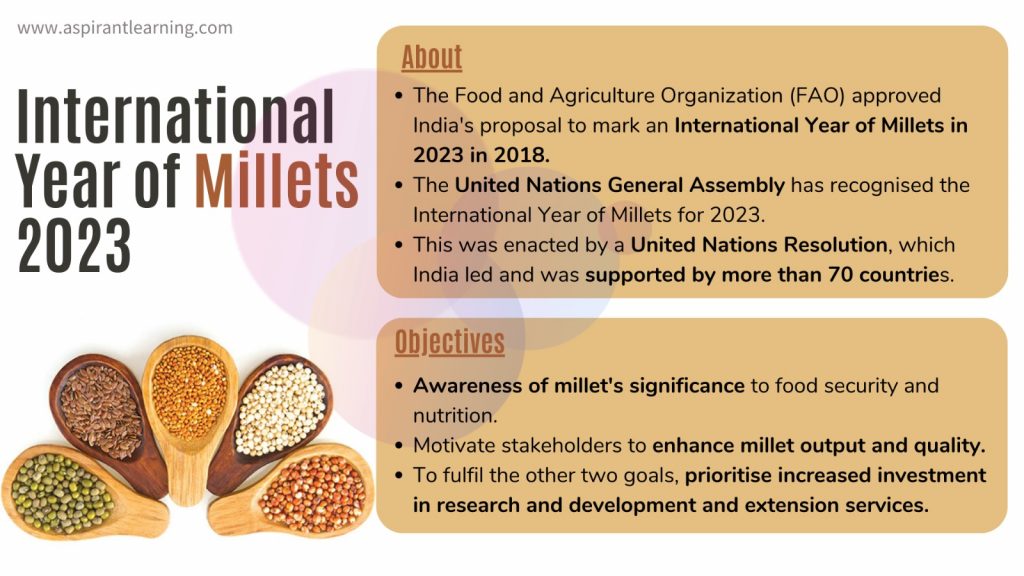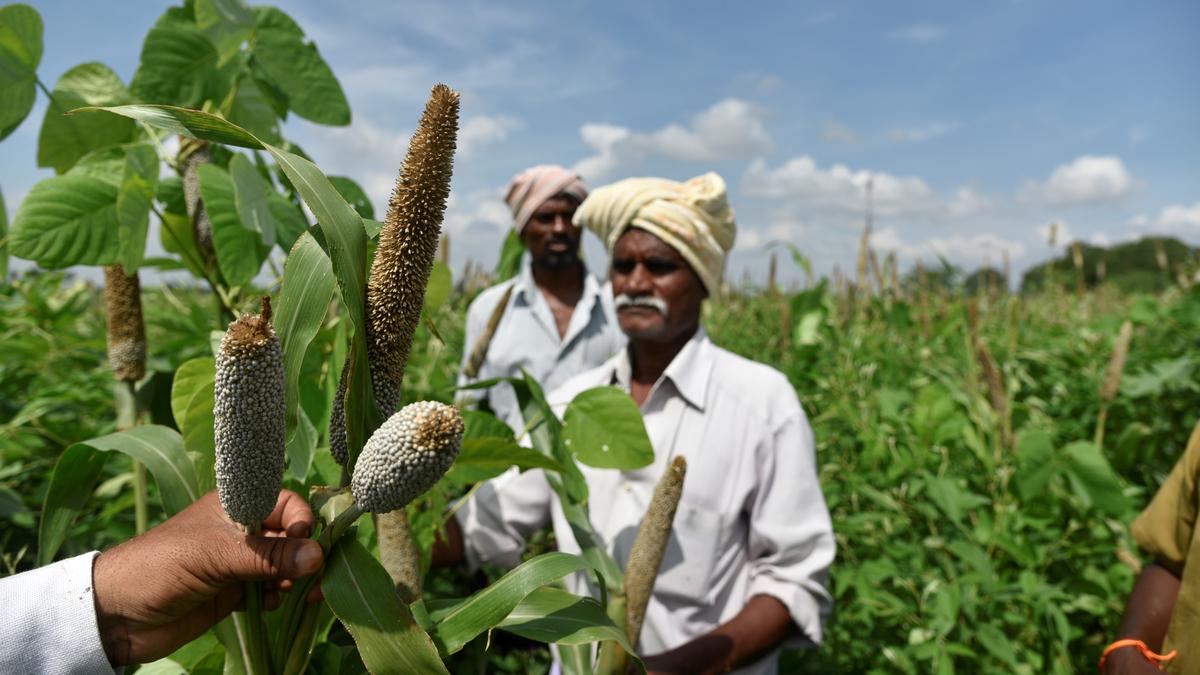News Highlight
India’s Millet Revolution: There are lessons from Tamil Nadu to help make millet cultivation profitable.
Key Takeaway
- The United Nations Food and Agriculture Organization (FAO) has designated 2023 as the International Year of Millets.
- Millets offer unique nutritional attributes (rich in protein, dietary fibre, micronutrients, and antioxidants) and unique agronomic characteristics (drought-resistant and suitable for semi-arid regions).
Millet Production
- About
- Millet refers to a group of small-seeded annual grasses grown as grain crops, primarily on marginal soils in temperate, subtropical, and tropical countries.
- Ragi (Finger millet), Jowar (Sorghum), Sama (Little millet), Bajra (Pearl millet), and Variga(Proso millet) are some of the most prevalent millets available in India.
- They are also more hardy and drought-tolerant crops.
- Millets may grow in poor soils with little water, fertiliser, or insecticides.
- They can survive greater temperatures, making them ideal for ‘climate-smart cereals.
- These grains were among the first plants domesticated for food and were discovered in the Indus culture.
- It is grown in around 131 countries and is the traditional cuisine for approximately 60 million people in Asia and Africa.
- India is the world’s largest millet producer.
- It accounts for 20% of global and 80% of Asian output.
- Global Distribution
- India, Nigeria, and China are the world’s major millet growers, accounting for more than 55% of total production.
- India was a significant producer of millet for many years.
- However, millet production in Africa has expanded substantially in recent years.
- Pearl millet is India’s fourth most extensively produced food crop, after rice, wheat, and maise.
- Millets are widely accessible in India.
Significance of Millet Production
- Millets can also aid with health issues like obesity, diabetes, and lifestyle issues because they are gluten-free, have a low glycemic index, and are substantial in dietary fibre and antioxidants.
- Millets are Nutri-cereals abundant in nutrients such as protein, essential fatty acids, dietary fibre, B-Vitamins, and minerals such as calcium, iron, zinc, potassium, and magnesium.
- It has the potential to offer nutritional security and guard against nutritional deficits, particularly in children and women.
- It will also be vital for climate change mitigation strategies in the drylands and smallholder and marginal farms.
- Millets are photosensitive (need no specific photoperiod to flower) and resistant to climate change.
- Millets may grow on poor soils with little or no outside help.
- Millets require less water and may grow in drought circumstances, without irrigation, and even in very low rainfall regimes.
- Millets have a low environmental and water footprint (rice plants need at least 3 times more water to grow than millets).
Challenges of Millet Production
- Mono-cropping
- The Green Revolution changed the planting pattern from wheat to paddy.
- Millet farming decreased from 37 million hectares before the Green Revolution to 14 million hectares.
- Inconsistent Supply and Demand
- Millets were consumed by less than 10% of rural and urban households, according to the NSSO household consumption expenditure survey.
- The Millets Mission has included grain in the public distribution system, but the quotas are limited.
- Processing Issues
- Some millets require additional processing steps to optimise grain recovery and polishing to keep their nutritional content.
- Ease of Consumption
- Wheat contains gluten proteins, which swell and form networks when wet, making the dough more cohesive and stretchy.
Initiatives Taken by The Government
- They increased the Minimum Support Price for Millets, providing a significant price incentive to producers.
- Furthermore, the government has placed millet in the public distribution system to ensure a consistent market for the commodity.
- The government has begun to provide farmers with seed kits and inputs.
- As well as to develop value chains through Farmer Producer Organizations and promote millets’ marketability.
- Initiative for Nutritional Security through Intensive Millet Promotion (INSIMP).

Conclusion
- Millet farming on a large scale can help farmers protect their livelihoods in the face of climate change.
- Because of their nutritional content, the widespread adoption of millets can also help address lifestyle disorders such as diabetes.
- The government has taken various praiseworthy steps to increase millet output.
- Efforts should be increased to increase the area under millet cultivation.
Pic Courtesy: The Hindu
Content Source: The Hindu



